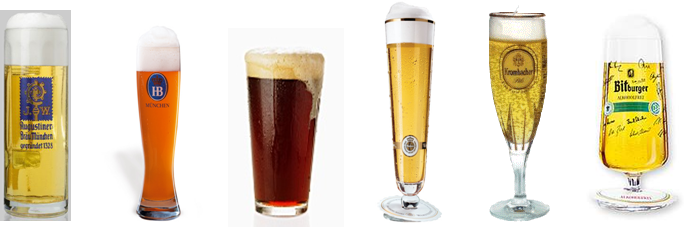Beer Types, Part I
 Saturday, October 16, 2010 at 15:56
Saturday, October 16, 2010 at 15:56 In the Schnitzelbahn Bier Tournament, the structure and “competitors” were not really planned in advance. The competitors emerged as we discovered simply what was available in two local supermarkets. The structure evolved as we assessed the beers we had collected and started learning about formal “types” of beer – then we grouped the beers we had on hand in a way that made sense. This is the result:
We knew that it would be Munich-biased, and so it is: Helles (“light”), Weiss (“wheat”), and Dunkel (“dark”) are more traditionally Bavarian beers. Although Pilsner has Czech and northern German roots, it is the most consumed in Germany (and the world) so also has a strong presence in Bavaria too (and forms the basis for most export beer). More regional German beer types like Alt (“old”) and Kölsch (from Köln / Cologne) did not make the cut, and will be addressed in another tournament.
We also recognized that at the core, a “winner” between two beers is really a matter of personal taste. Therefore, we decided to determine our favorite beer of each type first, before pitting different beer types against each other. You really can’t claim a Dunkel is “better” or “worse” than a Helles, because they are fundamentally different. When it comes to the “final four”, our champion will be just our favorite beer, regardless of type. We’re not even tasting the beers in the “correct” type of glass (see pic below, with credits to Augustiner Helles maß, Hofbräu Weissbier glass, some random Dunkles glass, and Pilsner glass types from Warsteiner, Krombacher, and Bitburger).

But this process begs the question: What are the formal types of beer? What are we really comparing in the tournament? Should we really be using different kinds of glasses???
You can spend hours reading Internet sources on the topic of beer types (also addressed as categories, sub-categories, styles, sub-styles, etc.) Online sources range from individual web pages to the Beer Judging Certification Program, with its 1.4MB / 51 page manual! And that is before reading books by the grandfather of beer typology, Michael Jackson.
But we learned something from just the first readings on this topic. Beer traditionally has only four components: water, a sugar source (usually a grain), yeast, and hops (by the old laws, German beers had only 3, but the yeast was naturally ocurring, thus not considered an ingredient).
Almost every brewer begins with the same high-level distinction: Beer can be an Ale or a Lager. This distinction addresses the differences in the yeast used and how it affects the brewing process.

Note: Lambic is a third type commonly found, but how to address this type and other/mixed types is inconsistent.
The name "Lager" actually comes from the German verb "lager" (to store), denoting that this type of beer was stored longer than Ale, and produced a clearer beer.
Below this first level of distinction between Ale and Lager, beer categorization methodologies start to fragment almost immediately. A Google search bring up a “family tree of beer styles”, a “periodic table of beer styles”, and other amateur and commercial mappings.
Some sources try to get pretty scientific about measuring beer types, using color, sweetness, bitterness, and even specific gravity scales! I also found a "flavor wheel" similar to what some wine tastings use -- basically to help the drinker put descriptors to the experience, put prose to chemistry.
Beer Evaluation sources: Color, Bitterness vs Specific Gravity, Bitterness vs Sweetness, and "Flavor Wheel"
But the main point of interest for us is that about three-fourths of the beers in our tournament are Lagers (Helles, Pilsner, and Dunkel) and only a handful are ales (Weissbier or Weizen). I think Frau A will want more ales in the next tournament, because she really likes Weissbier!
We’re doing further reading on beer categories, and overall, I find the current ways of describing beer unsatisfying for the average beer drinker. They’re either too microscopic (who really can tell the difference between an regular ale and a “premium” ale?) or just don’t make sense (why are some beers categorized by ingredient like wheat, and others are grouped by geography like Scottish Ale and “Vienna-style”???) This needs to change! Look for this topic in another post soon.
 Herr J ...
Herr J ...  Post a Comment
Post a Comment  Beer tagged
Beer tagged  beer,
beer,  beer bracket,
beer bracket,  beer categories,
beer categories,  beer styles,
beer styles,  beer tournament,
beer tournament,  beer types
beer types  1 Reference ...
1 Reference ...  Print Article
Print Article  Email Article
Email Article 















Reader Comments